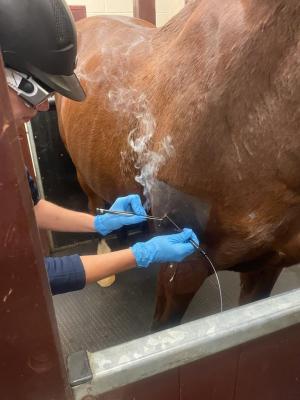Equine Therapy Programs: Transforming Lives One Ride at once
Equine Therapy Programs: Transforming Lives One Ride at once
Blog Article
Laser Therapy in Equine Therapy: A Modern Technique to Improving Horse Wellness
Laser therapy has actually emerged as a crucial technique in equine treatment, using focused light energy to foster cellular fixing and speed up healing from a selection of ailments. By promoting mitochondrial task and boosting ATP production, laser treatment not just improves flow yet also offers significant pain alleviation.
Understanding Laser Treatment
Laser treatment, a non-invasive therapy method, has gained considerable traction in equine medicine due to its efficacy in promoting recovery and discomfort relief. Enhanced ATP levels accelerate cells repair work processes and lower swelling, making laser therapy particularly reliable for treating musculoskeletal injuries, injuries, and other inflammatory conditions in steeds.
There are several types of lasers made use of in equine therapy, each with specific wavelengths and power results tailored to various restorative needs. Low-level laser treatment (LLLT), also called cool laser therapy, employs reduced power levels to promote cell function without creating thermal damages. High-intensity laser therapy (HANDLE), on the other hand, utilizes greater power degrees to accomplish deeper cells penetration and more substantial restorative impacts.
Veterinarians use numerous laser devices and strategies depending upon the condition being treated and the wanted depth of cells penetration. Correct training and knowledge are essential for ensuring the risk-free and reliable application of laser therapy, consequently maximizing its healing potential while lessening risks.
Benefits for Horse Health
With a strong understanding of exactly how laser therapy functions, it is very important to explore its many advantages for equine wellness. One of the main benefits is its capacity to speed up cells repair service and cell development. By boosting mobile feature, laser therapy advertises faster wound recovery and help in the regrowth of broken cells. This can be specifically beneficial in decreasing recovery times for horses experiencing injuries.
Additionally, laser therapy has been revealed to boost flow, consequently enhancing blood flow to affected locations. Boosted flow guarantees that important nutrients and oxygen are supplied much more successfully, promoting the healing process. Furthermore, laser treatment's anti-inflammatory results assist in decreasing swelling and pain, which is vital for the general well-being of the equine.
Pain monitoring is one more significant advantage. By releasing endorphins and obstructing pain signals, laser treatment offers reliable, non-invasive relief from both acute and persistent discomfort. This can add to improved flexibility and lifestyle for the pet.
Finally, laser treatment is a non-invasive treatment alternative, lessening the risk of difficulties connected with even more invasive treatments. Its convenience and effectiveness make it an important device in modern-day equine vet medicine.
Typical Problems Treated

One more common problem treated with laser treatment is joint inflammation. Horses experiencing both intense and chronic arthritis benefit from the anti-inflammatory impacts of laser therapy, which assists to alleviate pain and enhance joint feature. In addition, laser therapy is used in the management of injuries. Whether managing surgical lacerations or traumatic injuries, the modality advertises much faster cells fixing and lowers the threat of infection.
Equine respiratory system problems, such as reoccurring airway blockage (RAO), likewise respond favorably to laser therapy. Laser treatment is useful in dealing with hoof problems, including laminitis and abscesses.
Procedure and Safety
Implementing laser treatment in equine treatment my response includes a careful procedure to make sure both efficiency and safety and security. Equine Therapy. The process begins with a complete vet evaluation to figure out the suitability of laser treatment for the horse's particular condition. As soon as deemed proper, the therapy location is prepared by cleansing and, if necessary, clipping the hair to boost laser infiltration
The expert has to select the appropriate sort of laser, typically a low-level laser (LLLT) or a high-power laser (HPL), depending on the problem being dealt with. The laser tool is then adjusted to the appropriate wavelength, power, and duration setups. Throughout the application, the expert moves the laser over the targeted area in a methodical way, guaranteeing constant and also exposure.
Safety and security protocols are strictly complied with, consisting of making use of safety glasses for both the practitioner and the steed. In addition, it is essential to keep an eye on the equine for any kind of signs of discomfort or unfavorable responses throughout the treatment. Post-treatment, the horse is usually provided a duration of remainder to enable the restorative impacts to show up.

Future of Equine Laser Therapy
As innovations in veterinary medicine proceed to unfold, the future of equine laser treatment holds significant assurance. Emerging innovations and much deeper clinical understandings are set to fine-tune and increase the applications of laser treatment for steeds. One of the most awaited developments is the combination of innovative imaging strategies that enable for more exact targeting of damaged tissues, thus boosting restorative outcomes. Furthermore, the growth of mobile and easy to use laser gadgets is likely to make this treatment extra easily accessible to a broader array of professionals and horse proprietors.
In addition, recurring research study right into the molecular and mobile mechanisms of laser therapy will likely generate find out this here optimized procedures tailored to particular problems, improving efficiency and minimizing treatment times. Individualized therapy strategies based on genetic and biochemical markers can come true, guaranteeing that each steed receives one of the most appropriate and reliable care.
Furthermore, regulatory innovations and standardization of protocols will enhance the reliability and dependability of laser treatment in equine practice. Equine Therapy. As these innovations continue to emerge, equine laser treatment is positioned to end up being a crucial part of veterinary care, offering boosted recovery and enhanced high quality of life for horses internationally
Final Thought

Report this page